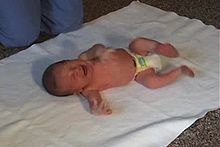Moro reflex
The Moro reflex ( clasp reflex , clasping reflex ) occurs in young animals of many mammals . It was named after the doctor Ernst Moro , who described the reflex in 1918.
In humans, the unexpected falling or leaning back of the infant into the supine position leads to a jerky stretching of the arms, spreading of the fingers and opening of the mouth, then the arm and hand movement is reversed and ends in a fist; if the reaction is strong, there will also be a flexion of the legs at the hips. Frightful situations can also trigger the Moro reflex, which parents often perceive as a flinch. It is not uncommon for the symptoms of West syndrome to be confused with the movement patterns that occur in the Moro reflex.
The Moro reflex is vital for the young infant because it enables z. B. the first breath and helps to open the windpipe if the newborn is about to choke. It forms in humans in the 9th week of pregnancy and disappears from the 3rd / 4th week of pregnancy . Month of life through the maturation of the nervous system . It can be triggered by all channels of perception (auditory, visual, tactile, vestibular) and leads to a complex physical reaction (spontaneous movement of the upper extremity backwards, tone reaction in the face, release of stress hormones, drop in blood sugar level, increase in heart rate and breathing rate) .
In the advisory literature there is sometimes the recommendation to use tight wrapping in a cloth (" swaddling ") to prevent the infant from waking up in the first months of life while sleeping due to the Moro reflex. The procedure is controversial.
In young animals that are carried by their parents on the body, the Moro reflex also prevents falling from their parents' body by reaching in the fur. Evolutionary biologists therefore see the Moro reflex as an indication that human infants are formerly active carriers .
Individual evidence
- ↑ a b Bronisch, FW: The reflexes. Georg Thieme Verlag, Stuttgart 1979, ISBN 3-13-494005-1 , p. 88.

